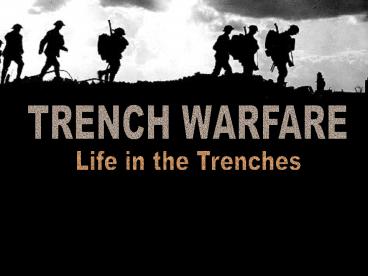TRENCH%20WARFARE - PowerPoint PPT Presentation
Title:
TRENCH%20WARFARE
Description:
Creating the trenches - How they looked - Inside the trench - Tools used Dangers in the trenches What the trenches were like the worst part of trench life etc. – PowerPoint PPT presentation
Number of Views:263
Avg rating:3.0/5.0
Title: TRENCH%20WARFARE
1
TRENCH WARFARE
Life in the Trenches
2
TABLE OF CONTENTS...
- Creating the trenches
- - How they looked
- - Inside the trench
- - Tools used
- Dangers in the trenches
- What the trenches were like the worst part of
trench life etc. - How the soldiers died in the trenchessnipers,
hunger etc. - The diseases and problems within the trenches
lice, rats etc. - Days in the trenches
- Time spent in the trenches
- Duties in the trenches
- Food/ Food supplies
3
How they Looked
Trench formation
4
(No Transcript)
5
Trench Construction diagramfrom 1914 British
Army Manual
6
Aerial View of Trench Systems
7
Inside the Trenches
- Fire-step
- Duckboards
- Dugouts/funk holes
- Latrines
Inside the trenches...
8
Building it
- Entrenching tool (early spade/shovel)
- Song --gt
O,O,O its a lovely war! What do we want with
eggs and ham? When we have plum and apple
jam Form fours, right turn How shall we spend the
money we earn? O,O,O its a lovely war!
The Entrenching tool
9
Weapons of Trench Warfare
10
The Machine Gun
The Machine Gun
- The Machine Gun (GATLIN GUN) efficient warfare.
- It was a way of keeping the other army in their
trench. - Also used in combo with barbed wire to funnel
soldiers - Once funneled into a specific area, soldiers
could be killed - en masse
11
Barbed Wire
Barbed wire was used to slow down advancing
troops. The barbed wire was also used to force
soldiers to charge through certain openings in
the fence.
12
Artillery
Artillery
- A barrage is a term used to describe extensive
artillery fire against enemy positions. - A light barrage 6-7 per 10mins.
- A moderate barrage 30 shells per min.
- A heavy barrage 50-60 shells per min.
13
Poison Gas!
- Chlorine Mustard Gas were used
- Chlorine Gas inhaled to be deadly (at Ypres
1914) - Mustard gas was the more effective weapon (1917)
- It was fired into the trenches in shells.
- Colorless almost odorless
- Took 12 hours to take effect.
- Effects include blistering skin, vomiting,
- sore eyes, internal and external bleeding.
- Death can take up to 5 weeks.
- More severe than Chlorine Gas due to the need to
cover the entire body
14
What the Trenches were Like
- The trenches were filled with water
- Constant mud
- Duckboards
- Latrines
- Trench grounds in winter and autumn
- Dead bodies
The amount of water and mud in the trenches
15
How the Soldiers Died
Soldiers picking up bodies from No Mans Land
- Falling off duckboards and into the mud
- Buried alive
- Suicide
- Enemy snipers
- Diseases
- Lack of food
Trench walls collapsed
Dead soldiers on the ground
16
TRENCH FOOT!!!!
17
Mrs. Helmers Trench Foot
18
The Diseases and Problems
- Trench foot
- The pyrrexhia or trench fever
- Lice
- Rats
- Dysentery
Soldiers sick from a diseases
Soldiers sick while in their trenches
19
Rat Infestation
- Millions of rats infested trenches.
- The brown rat was especially feared.
- Gorging themselves on human remains (grotesquely
disfiguring them by eating their eyes and liver)
they could grow to the size of a cat. - A single rat couple could produce up to 900
offspring in a year, spreading infection and
contaminating food.
20
Frogs, lice and worse
- Lice caused intense itching
- Even when washed, eggs remained everywhere
- Lice caused Trench Fever, a particularly painful
disease that began suddenly with severe pain
followed by high fever. - Many men chose to shave their heads entirely to
avoid nits. - Frogs by the score were found in shell holes
21
Time spent in the trenches
- Of a 32 Day period 8 days in a front line
trench, 8 days in a reserve trench and 16 days
away from the front, in a small town or village
nearby. - A British/Canadian soldiers year could be divided
as 15 front line, 10 support line, 30
reserve line, 20 rest, and 25 other. (
hospital, traveling, leave etc.) - Everything could be changed if theres and
offensive attack. Soldiers could spend up to 6
weeks in the front line trenches before they
could take a break. - Time in the trenches alternated with long periods
of boredom, and short periods of fear. - Soldiers quiet time
Soldiers during there rest period.
Soldiers looking over there trench.
22
Duties in the Trenches
- Soldiers had to replace the barbed wire, repair
the flooded trenches, and clean the latrines.
These duties were all called fatigues - The maintenance and expansion of the barbed wire
fences and the trenches was done at dark, when it
was harder to be detected. - The work was done at night Most of their
work was done at night when patrols were sent out
to observe and check out on the enemy trenches,
and the repair of their own front line and
gather of create/prepare other defenses. - On breaks from fighting in the trenches, the
soldiers were assigned different duties such as
moving supplies or helping to repair things.
Soldiers switching from line to line.
Soldiers working with there trenches
23
THE END!































